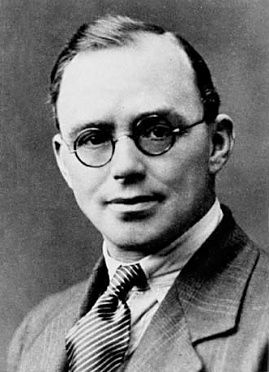Arthur Horner (trade unionist) facts for kids
Quick facts for kids
Arthur Horner
|
|
|---|---|
 |
|
| Born | 5 April 1894 Merthyr Tydfil, Mid Glamorgan, Wales
|
| Died | 4 September 1968 (aged 74) London, England
|
| Occupation | General Secretary of the National Union of Mineworkers (NUM) |
| Political party | ILP (until 1921) CPGB |
Arthur Lewis Horner (born April 5, 1894 – died September 4, 1968) was a famous Welsh trade union leader. He was also a communist politician. He worked hard to improve the lives of miners in Britain. He led the South Wales Miners Federation (SWMF) and later the National Union of Mineworkers (NUM).
Contents
Arthur Horner's Early Life
Arthur Horner was born in Merthyr Tydfil, South Wales. He was the oldest son in a large family. His father worked at a railway station. His grandfather and two uncles were miners.
Arthur first worked as a grocery assistant. Later, he worked at the Merthyr railway station. In 1915, he started working in coal mining. He became interested in trade unions and their fight for workers' rights.
Getting Involved in Politics
Arthur Horner first joined the Independent Labour Party. He looked up to Keir Hardie, a politician who represented Merthyr Tydfil.
Arthur moved to Ynyshir in the Rhondda Valley. There, he met Noah Ablett, a strong trade union leader. Noah taught classes about Marxism, which Arthur attended. Arthur had been very religious as a teenager. He even trained to be a preacher. This training helped him become a confident public speaker.
Standing Up Against War
During the First World War, Arthur Horner did not want to fight. He believed in workers from all countries sticking together. In 1917, he went to Dublin, Ireland, to avoid being arrested for not joining the army.
Arthur supported Irish Home Rule, which meant Ireland governing itself. He joined the Irish Citizen Army, a group involved in the 1916 Easter Rising. He felt Ireland was fighting for true freedom.
When he returned to Britain, he was arrested. He was sent to prison for six months. After his sentence, he was arrested again and sent to another jail. The South Wales Miners Federation (SWMF) fought for his release. They even elected him as a "checkweighman" at Mardy Colliery. This was a job where he checked the weight of coal miners dug.
To put more pressure on the authorities, Arthur started a hunger strike. He refused food and water. After six days, he was finally released in May 1919.
Joining the Communist Party and Leading Unions
In 1921, Arthur Horner became a founding member of the Communist Party of Great Britain (CPGB). He helped start the National Minority Movement in 1924.
In 1926, he was elected to the SWMF executive committee. He played a big part in the ten-month-long "lockout" of coal miners that year. This happened after the 1926 United Kingdom general strike.
Challenges and Learning
In the early 1930s, Arthur had disagreements with the CPGB. He even faced being kicked out of the party. He traveled to Moscow in 1931 to explain his views. Both sides admitted some mistakes, and Arthur was able to stay in the party.
In 1932, Arthur was put in prison on false charges. While there, he studied a book called The Art of War by Carl von Clausewitz. This book taught him a lot about strategy. It made him think carefully about when and how to strike. He learned that too many unplanned strikes could weaken the union.
Leading the Miners
Arthur Horner ran for Parliament in 1933 but did not win. However, in 1936, he was elected President of the South Wales Miners' Federation. He held this position until 1946. He helped make agreements with coal owners that improved wages and working conditions for miners.
During the Second World War, Arthur was on the Executive of the Miners' Federation of Great Britain. He used the union's strong position to get better pay and conditions for miners. He worked with the government and coal owners to make sure coal production stayed high during the war.
In August 1946, Arthur Horner became the General Secretary of the new National Union of Mineworkers (NUM). This union brought together all the different coalfield unions. Arthur was very respected. He guided the union's plans for when the coal industry became owned by the government (nationalized).
The NUM had a list of demands called the 1946 Miners' Charter. These demands included:
- A five-day working week with no pay loss.
- A guaranteed weekly wage that was as good as other industries.
- Two weeks of paid holiday.
- Good pensions for miners at age 55.
- Modernizing old mines and building new ones.
- Good training for young miners.
- New safety laws.
- Fair payments for injuries and diseases from mining.
- Building new towns and villages with good homes for miners.
The government agreed to these demands quickly. They needed the NUM's full support to make nationalization work and to increase coal production. The coal industry became nationalized on January 1, 1947. By 1955, all 12 points of the Miners' Charter had been achieved.
When Arthur Horner retired in 1959, the NUM had achieved some of the best working conditions and pay for its members in all of British industry.
In 1959, he was given the special honor of being made a Freeman of Merthyr Tydfil.
Arthur Horner passed away in 1968 at the age of 74.
Images for kids



